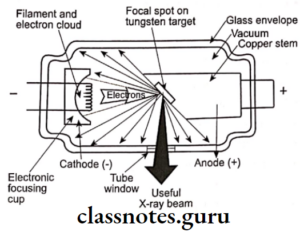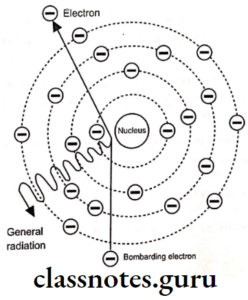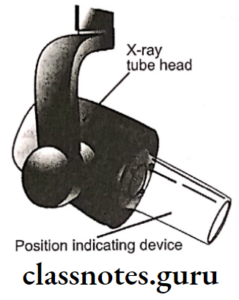Production Of Ray
Important Notes
- The X-ray machine has an X-ray tube, which consists of
- Cathode, which serves as a source of electrons.
- Anode (target) at which beam of high-speed electrons are directed
- The cathode has filaments and a focusing cup.
- Filaments are coils of Tungsten, which is the source of electrons within the X-ray tubes.
- The Molybdenum Focusing Cup focused the electrons within the X-ray tubes.
- The anode is composed of a Tungsten Target and Copper Steam.
- The target serves the purpose of converting the kinetic energy of electrons emitted from the cathode source into X-ray photons.
- Tungsten is selected because of its properties such as high atomic number, high melting point, and low vapor pressure.
- Copper Stem dissipates heat thereby reducing the risk of target melting.

Production of X-ray long essay
Production Of Ray Long Essays
Question 1. What are the parts of an X-ray tube? Describe the working of the X-ray tube and add a note on Bremmstrahlung radiation.
Answer.
Apparatus:
- Cathode:
- Filaments
- Focussing cup
- Anode
- Tungsten target
- Copper stem
- Glass tube:
- It encloses the above apparatus
- Cathode:
- Filaments
- Made up of tungsten wire
- It is connected to an electric current
- On passage of electric current through this filament, it gets heated and emits electrons
- A milliampere current controls the number of electrons
- Focussing cup
- It is made up of molybdenum
- It is a concave reflector cup
- The electrons emitted from the filament are received by it
- These electrons are then focused toward the focal spot, which is the anode
- Filaments
- Anode:
- Tungsten target
- This converts the kinetic energy of electrons into X-ray photons
- Copper stem
- It is a good thermal conductor
- Tungsten target
Electric current → heats the filament → Electrons are emitted from it → Electrons get collected towards the focusing cup → this focusing cup reflects the electrons to the tungsten target → this tungsten target converts electrons to X-ray photons
Production of X-ray short note

Bremmstrahlung Radiation:
- These are produced due to high-speed electrons
- These electrons pass just near the nucleus
- These are attracted by the positively charged nucleus
- This leads to the loss of some of its kinetic energy
- Further results in deflected and decelerated electrons and low-energy photons
Read And Learn More: Oral Radiology Question and Answers

When an electron comes close to the nucleus of a tungsten atom and is slowed down, an X-ray photo of lower energy, known as general radiation, results

An electron that dislodges an inner shell electron from the tungsten atom results in the rearrangement of the remaining orbiting electrons and the production of an X-ray photon known as characteristic radiation
Production of Ray Short Essays
Question 1. X-ray machine/Working of X-ray tube.
Answer.
Apparatus:
- Cathode:
- Filaments
- Focussing cup
- Anode
- Tungsten target
- Copper stem
- Glass tube:
- It encloses the above apparatus
- Cathode:
- Filaments
- Made up of tungsten wire
- It is connected to an electric current
- On passage of electric current through this filament, it gets heated and emits electrons
- A milliampere current controls the number of electrons
- Focussing cup
- It is made up of molybdenum
- It is a concave reflector cup
- The electrons emitted from the filament are received by it
- These electrons are then focused toward the focal spot, which is the anode
- Filaments
- Anode:
- Tungsten target
- This converts the kinetic energy of electrons into X-ray photons
- Copper stem
- It is a good thermal conductor
- Tungsten target
X-ray production process essay
Electric current → heats the filament → Electrons are emitted from it → Electrons get collected towards the focusing cup → this focusing cup reflects the electrons to the tungsten target → this tungsten target converts electrons to X-ray photons


Question 2. Position indicating device [PID].
Answer.
Position indicating device [PID]
It is an open-ended lead cylinder that extends from the opening of the metal housing of the tube head, also called the “cone.”
It appears as an extension of the tube head
Position Indicating Device Types:
- Conical
- Rectangular
- Round
Position Indicating Device Significance:
- Long PID results in a less divergent X-ray beam
- This minimizes the irradiation of tissues
- Causes an increase in target film distance
- This further improves the quality of the image

X-ray generation long and short answer questions
Question 3. Production of X-ray
Answer.
Production of X-ray
- Potential differences develop between the cathode and the anode
- This results in the emission of electrons from the tungsten filament
- The emitted electrons are stopped suddenly at the focal spot
- This sudden stoppage causes the conversion of electrons into X-ray photons
- The heat generated during the process is absorbed by the oil circulated in the glass of the X-ray tube
Production of X-ray Mechanism:
- Bremmstrahlung Radiation:
- These are produced due to high-speed electrons
- These electrons pass just near the nucleus
- These are attracted by the positively charged nucleus
- This leads to the loss of some of its kinetic energy
- Further results in deflected and decelerated electrons and low-energy photons
- Characteristic radiation:
- The high-energy electrons hit the target atom
- Electrons are ejected from the inner orbit
- This leads to a vacancy that is filled with electrons from the outer orbit
This results in the emission of a photon whose energy is equivalent to the difference in the energy levels of two orbits

When an electron comes close to the nucleus of a tungsten atom and is slowed down, an X-ray photo of lower energy, known as general radiation, results

An electron that dislodges an inner shell electron from the tungsten atom results in the rearrangement of the remaining orbiting electrons and the production of an X-ray photon known as characteristic radiation
X-ray tube working principle essay
Production Of Ray Short Answers
Question 1. Bremmstrahlung radiation.
Answer.
Bremmstrahlung radiation
- These are produced due to high-speed electrons
- These electrons pass just near the nucleus
- These are attracted by the positively charged nucleus
- This leads to the loss of some of its kinetic energy
- Further results in deflected and decelerated electrons and low-energy photons

When an electron comes close to the nucleus of a tungsten atom and is slowed down, an X-ray photo of lower energy, known as general radiatio,n results

An electron that dislodges an inner shell electron from the tungsten atom results in the rearrangement of the remaining orbiting electrons and the production of an X-ray photon known as characteristic radiation
Question 2. Characteristic radiation.
Answer.
Characteristic radiation
- The high-energy electrons hit the target atom
- Electrons are ejected from the inner orbit
- This leads to a vacancy that is filled with electrons from the outer orbit
This results in the emission of a photon whose energy is equivalent to the difference in the energy levels of two orbits
X-ray tube with a rotating anode, which allows the head at the focal spot to spread out across a large surface area
Question 3. Focal spot.
Answer.
Focal spot
- The area of the target at which the electrons are absorbed and X-rays are generated is called the focal spot
- The size and shape of the focal spot are determined by the size and shape of the electron stream when it hits the anode
Focal spot Types:
- Actual focal spot
- It is the area on the anode that is struck by the electrons
- Effective focal spot
- It is the length and width of the emitted X-ray beam as projected down the central axis of the X-ray tube
Production of X-ray physics essay
Production Of X-Ray Viva Voce
- The cathode of the X-ray tube is made up of tungsten
- Anode is made up of tungsten embedded in a copper stem
- The target is kept at an angle of 20°
- Radiations produced from focal spots are primary radiations
- Radiations that are reflected from objects are secondary
- Factors necessary for the production of X-rays are a source of electrons, an accelerator, and a target
- 0.2 – 0.8% of cathode rays are transformed into X-rays after striking the anode target.
- The average wavelengths of X-rays used in dentistry is 0.6 – 1 A.U.
- X-rays
Production of X-rays in radiology exam questions

